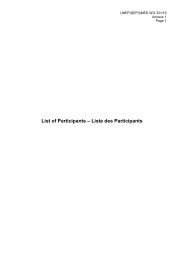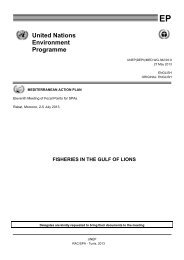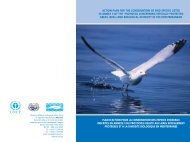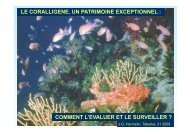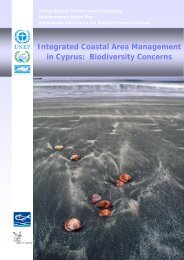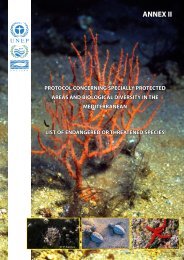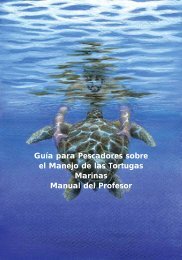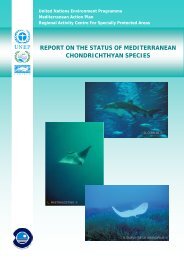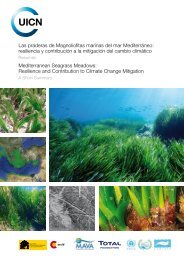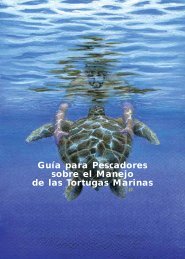Proceedings of the Second Mediterranean Symposium on Marine
Proceedings of the Second Mediterranean Symposium on Marine
Proceedings of the Second Mediterranean Symposium on Marine
You also want an ePaper? Increase the reach of your titles
YUMPU automatically turns print PDFs into web optimized ePapers that Google loves.
BIOMONITORING OF ENVIRONMENTAL METLLIC CONTAMINATION<br />
Céline LAFABRIE 1<br />
, Buno ANDRAL2 , Lila FERRAT1 , Vanina LEONI 1<br />
., Christine PERGENT-<br />
MARTINI1 , Didier SAUZADE2 1 Equipe EqEL, Université de Corse, 20250 CORTE, France<br />
2 Ifremer PAC, BP 330, 83507 La Seyne st Mer Cedex - France<br />
ABSTRACT<br />
As part <str<strong>on</strong>g>of</str<strong>on</strong>g> <str<strong>on</strong>g>the</str<strong>on</strong>g> MONIQUA program initiated by <str<strong>on</strong>g>the</str<strong>on</strong>g> Corsican Territorial Collectivity, <str<strong>on</strong>g>the</str<strong>on</strong>g><br />
biom<strong>on</strong>itoring <str<strong>on</strong>g>of</str<strong>on</strong>g> metallic c<strong>on</strong>taminati<strong>on</strong> al<strong>on</strong>g <str<strong>on</strong>g>the</str<strong>on</strong>g> Corsican coast (<str<strong>on</strong>g>Mediterranean</str<strong>on</strong>g>) have<br />
been carried out using Posid<strong>on</strong>ia oceanica (L.) Delile as bioindicator species. The<br />
analysis <str<strong>on</strong>g>of</str<strong>on</strong>g> mercury levels was realized in <str<strong>on</strong>g>the</str<strong>on</strong>g> belowground tissues (scales and rhizomes,<br />
by a lepidochr<strong>on</strong>ological study) <strong>on</strong> three sites: Bastia, Lumio and Macinaggio. The results<br />
show that mercury c<strong>on</strong>centrati<strong>on</strong>s are very weak, in both tissues, for all studied sites,<br />
compared to <str<strong>on</strong>g>the</str<strong>on</strong>g> literature data all over <str<strong>on</strong>g>the</str<strong>on</strong>g> <str<strong>on</strong>g>Mediterranean</str<strong>on</strong>g>, never<str<strong>on</strong>g>the</str<strong>on</strong>g>less, <str<strong>on</strong>g>the</str<strong>on</strong>g> site <str<strong>on</strong>g>of</str<strong>on</strong>g> Bastia<br />
appears more c<strong>on</strong>taminated than <str<strong>on</strong>g>the</str<strong>on</strong>g> o<str<strong>on</strong>g>the</str<strong>on</strong>g>rs. This result can be explained by <str<strong>on</strong>g>the</str<strong>on</strong>g> level <str<strong>on</strong>g>of</str<strong>on</strong>g><br />
anthropizati<strong>on</strong> <str<strong>on</strong>g>of</str<strong>on</strong>g> this site (e.g. demography). The use <str<strong>on</strong>g>of</str<strong>on</strong>g> a “correcti<strong>on</strong> factor”, based <strong>on</strong><br />
<str<strong>on</strong>g>the</str<strong>on</strong>g> relative <str<strong>on</strong>g>the</str<strong>on</strong>g>orical c<strong>on</strong>tributi<strong>on</strong> <str<strong>on</strong>g>of</str<strong>on</strong>g> scales and rhizomes weight to <str<strong>on</strong>g>the</str<strong>on</strong>g> belowground<br />
biomass allowed to highlight, for all sites, a significant decrease <str<strong>on</strong>g>of</str<strong>on</strong>g> mercury levels<br />
between 1997 and 2001.<br />
KEY WORDS: biom<strong>on</strong>itoring / mercurial c<strong>on</strong>taminati<strong>on</strong> / Posid<strong>on</strong>ia oceanica /<br />
<str<strong>on</strong>g>Mediterranean</str<strong>on</strong>g> Sea<br />
INTRODUCTION<br />
The Directive Cadre <strong>on</strong> Water 2000/60/CE, forecasts <str<strong>on</strong>g>the</str<strong>on</strong>g> setting <str<strong>on</strong>g>of</str<strong>on</strong>g> <str<strong>on</strong>g>the</str<strong>on</strong>g> ecological and<br />
chemical state <str<strong>on</strong>g>of</str<strong>on</strong>g> waters and associated ecosystems m<strong>on</strong>itoring. In this way, <str<strong>on</strong>g>the</str<strong>on</strong>g> Territorial<br />
Collectivity <str<strong>on</strong>g>of</str<strong>on</strong>g> Corsica initiated, in collaborati<strong>on</strong> with <str<strong>on</strong>g>the</str<strong>on</strong>g> regi<strong>on</strong>s <str<strong>on</strong>g>of</str<strong>on</strong>g> Sardinia and Tuscany,<br />
a communal programme INTERREG (N° MCD IIIA-03/08) aiming at setting a m<strong>on</strong>itoring<br />
<str<strong>on</strong>g>of</str<strong>on</strong>g> <str<strong>on</strong>g>the</str<strong>on</strong>g> waters and <str<strong>on</strong>g>the</str<strong>on</strong>g> marine littoral envir<strong>on</strong>ment quality (MONIQUA). This m<strong>on</strong>itoring<br />
necessity is not a recent approach and, if initially it was limited to <str<strong>on</strong>g>the</str<strong>on</strong>g> measure <str<strong>on</strong>g>of</str<strong>on</strong>g> <str<strong>on</strong>g>the</str<strong>on</strong>g><br />
physico-chemical parameters and <str<strong>on</strong>g>of</str<strong>on</strong>g> <str<strong>on</strong>g>the</str<strong>on</strong>g> c<strong>on</strong>taminants in <str<strong>on</strong>g>the</str<strong>on</strong>g> water masses and/or <str<strong>on</strong>g>the</str<strong>on</strong>g><br />
sediments (e.g. Réseau Nati<strong>on</strong>al d'Observati<strong>on</strong> – RNO), it is <str<strong>on</strong>g>the</str<strong>on</strong>g>n extended to <str<strong>on</strong>g>the</str<strong>on</strong>g> living<br />
matter using bioindicators organisms (Claisse and Cossa, 1999) allowing a real<br />
biom<strong>on</strong>itoring. This <strong>on</strong>e is based <strong>on</strong> <str<strong>on</strong>g>the</str<strong>on</strong>g> capacity <str<strong>on</strong>g>of</str<strong>on</strong>g> <str<strong>on</strong>g>the</str<strong>on</strong>g> bioindicator organism to<br />
c<strong>on</strong>centrate in its tissues <str<strong>on</strong>g>the</str<strong>on</strong>g> chemical c<strong>on</strong>taminants in a proporti<strong>on</strong>al factor to <str<strong>on</strong>g>the</str<strong>on</strong>g>ir<br />
bioavailability (Andral and Stanisière, 1999).<br />
The interest borne to Posid<strong>on</strong>ia oceanica (Linnaeus) Delile, in so far as a biological<br />
indicator is showed by many studies for about twenty years (Pergent, 1991). The use <str<strong>on</strong>g>of</str<strong>on</strong>g><br />
this species is justified by its l<strong>on</strong>gevity, its benthic character, its wide geographical<br />
repartiti<strong>on</strong>, its capacity <str<strong>on</strong>g>of</str<strong>on</strong>g> c<strong>on</strong>centrati<strong>on</strong> towards several stable pollutants (Pergent et al.,<br />
1995) and its capacity to memorise <str<strong>on</strong>g>the</str<strong>on</strong>g> mercury, which associated to <str<strong>on</strong>g>the</str<strong>on</strong>g> possibilities <str<strong>on</strong>g>of</str<strong>on</strong>g><br />
dating by lepidochr<strong>on</strong>ology, <str<strong>on</strong>g>of</str<strong>on</strong>g>fers <str<strong>on</strong>g>the</str<strong>on</strong>g> possibility <str<strong>on</strong>g>of</str<strong>on</strong>g> a temporal follow-up <str<strong>on</strong>g>of</str<strong>on</strong>g> this<br />
c<strong>on</strong>taminant (Pergent-Martini, 1998).<br />
ACTES DU DEUXIEME SYMPOSIUM MEDITERRANEEN SUR LA VEGETATION MARINE (ATHENES, 12-13 DECEMBRE 2003)<br />
175



